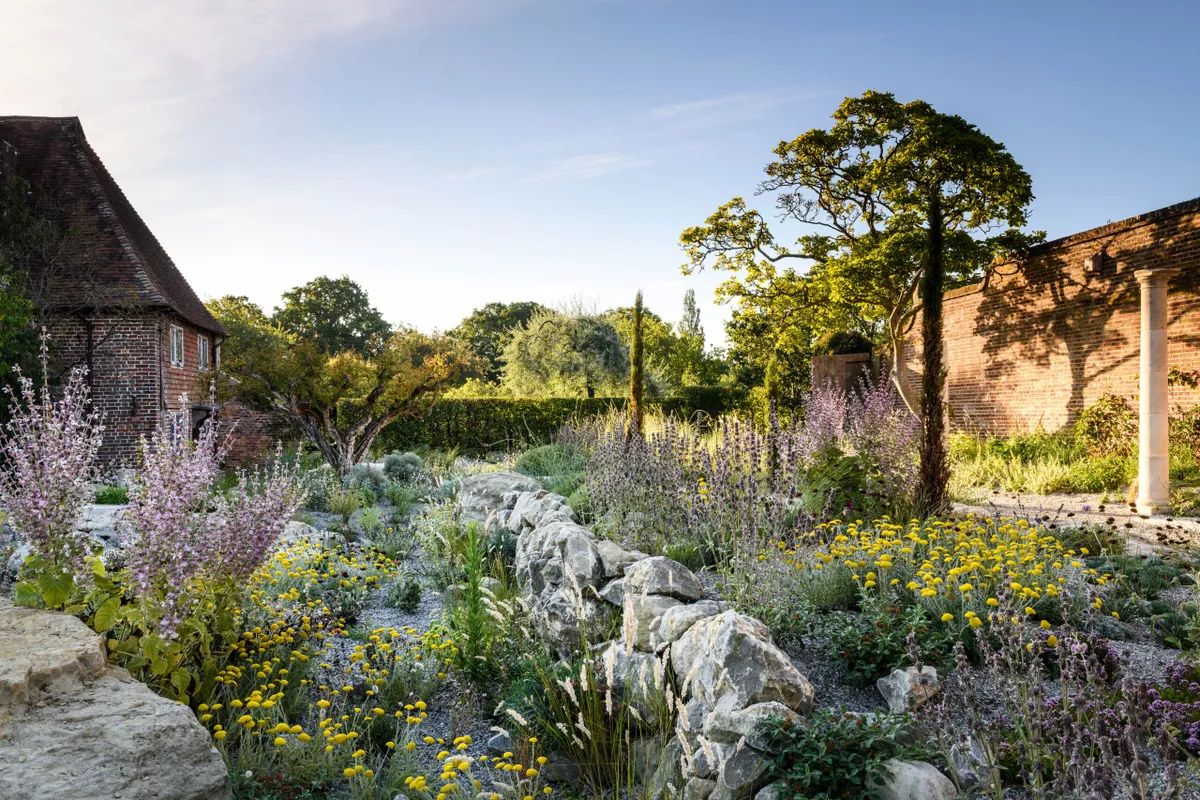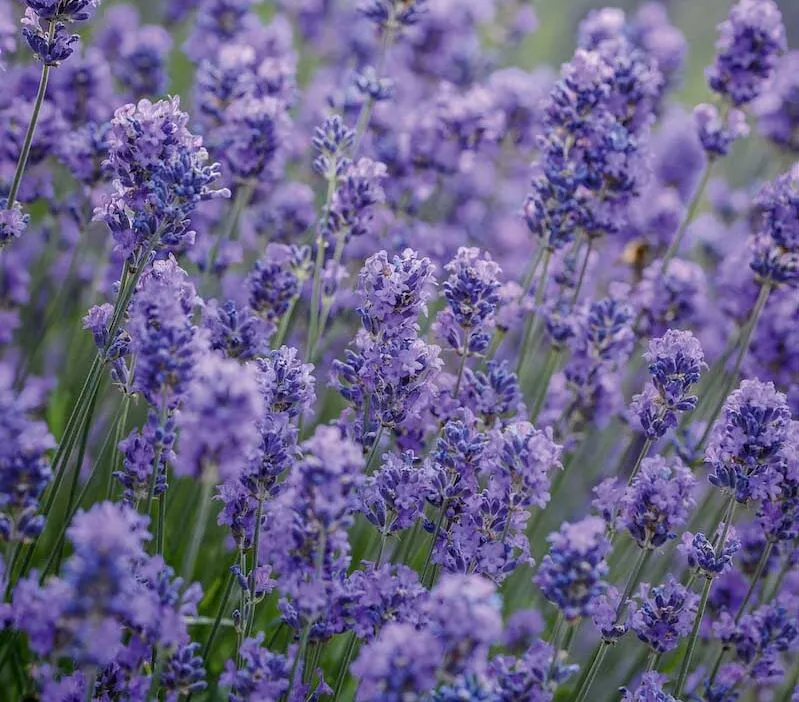Wondering whether you need to adjust your garden so that it's drought tolerant? Adapting to our changing climate may not be as simple as popping in a gravel garden. We asked expert gardeners and horticulturists to explain exactly what we need to consider in the UK when trying to become more drought tolerant.
Everything you need to know about drought tolerant gardens in the UK
What makes a plant drought tolerant?
Drought-tolerant plants often hail from Mediterranean climate zones around the world – around the Mediterranean sea, the western cape of South Africa, coastal California, central Chile and southern and southwestern Australia. They have evolved to thrive in habitats that have a very long, extremely hot and dry season – as much as six months with no rain – and poor soil.
You may also like
- What does drought mean for our gardens?
- Adapting to drought: how we should be gardening
- Best drought tolerant plants to grow
Leaves may be small or thin, grey or glaucous, hairy, succulent or fleshy. Many have very deep or wide root systems that seek out water, or underground storage organs (bulbs). Drought-tolerant plants are often low growing and form mounds – less likely to be dried by wind on a hot day. In their native habitats, they may go dormant or lose their leaves in summer.
Are Mediterranean plants suitable for the UK?

Garden designer James Basson, based in the South of France, points out: “The UK may increasingly have extremes of heat and wet through climate change, but its gardens have a depth of topsoil from our past temperate era, which makes conditions very different to the arid Mediterranean.” The plants he uses tolerate five to six months’ heat in Provence without rain in summer; droughts in the UK are more likely to last a few weeks.
“There’s a well-established climatic divide between the east and west of the British Isles,” says garden designer Matthew Wilson, who designed the famous Dry Garden at RHS Garden Hyde Hall. “This is more important than north/south in many ways. I’ve planted the same drought-tolerant plants that I have in my own garden in the east Midlands in gardens as far south as the Solent and as far north as Hexham in Northumberland, including Eryngium, Salvia, Stipa, Pennisetum and Artemisia. But I would probably think twice before trying them in a garden in Wales, Cornwall or the west coast of Scotland.
“The key really comes down to how well the soil drains. Beth Chatto [who created her famous a dry gravel garden in Essex] told me she grew drought-tolerant plants because she had to, with the rainfall in her garden lower than Jerusalem, Tunis and Rabat. Had she the rainfall of Cornwall or Wales she would have grown a completely different range of plants.”
Nurserywoman Derry Watkins created a gravel garden near Bath at around the same time as Beth Chatto, in order to grow the Mediterranean plants she loves on top of heavy clay. She points out that Mediterranean plants tend to ‘overgrow’ in the UK climate. “We’ve got too much rain, too much food and probably not enough sun, and they grow too big, too fast. We think we’re having a drought, but the plants don’t think so.”
What about wetter winters and unexpected cold snaps?
Annie Godfrey, who runs Daisy Roots Nursery and sells many drought-tolerant hardy perennials, advises: “If you’ve got dry soil, know why it’s dry. Is it dry clay or a light, free-draining soil? If it’s dry clay, drought-tolerant plants will hate the wet and cold in winter. You’re going to have to do a lot of soil improvement for good winter drainage.”
Encouragingly, a study conducted from 2005 to 2009 by the University of Reading found that Mediterranean plants including Stachys byzantina, Cistus x hybridus, Lavandula angustifolia and Salvia officinalis survived 17 days flooding in winter. Stachys and Lavandula also survived the same amount of flooding in summer.
Do I need to create a gravel garden?

“It’s fine to grow most drought-tolerant plants in ‘normal’ garden soil, provided the drainage is good and the soil doesn’t hold water over winter,” says Matthew Wilson. “It’s this latter point that is the make or break for drought-tolerant plants. In my own garden, I grow a mixture of drought-tolerant plants with ‘normal’ garden plants, such as Eryngium, Stipa and Verbena, alongside Eupatorium and Astrantia. I never water.
The plants have to get by with whatever rainfall we get, which in Rutland is quite low at an average of 647mm a year. The soil here is well drained, but I find the really specialised drought-tolerant plants such as Eschscholzia and Salvia candelabrum only really thrive in gravel and full sun. They need the heat, but also the drainage at the ‘neck’ of the plant, where otherwise they might suffer from fungal disease and rot.”
If your soil is heavy, grower Annie Godfrey advises adding humus in the form of leaf mould or mushroom compost – not manure, as it’s too rich. “Put a layer of 5cm of horticultural grit on top and dig it in to the top 20cm of soil so that you’re really opening it up,” she says.
“Drainage, drainage, drainage,” advises Derry Watkins. “Gravel, if possible, is the answer to all your problems. Top the soil with four – or better six or eight – inches. The deeper the gravel, the hardier the plants become.” She points out a gravel area could simply be a dedicated raised bed and that it will need a definite edge – it can’t just fade into lawn.
Do drought tolerant plants need watering?

“Drought tolerant doesn’t mean you can put plants in the ground and ignore them,” says Annie Godfrey. “You’re going to have to water and nurse them through their first season, so that they get a root system that’s going to sustain them through the following years”. Matthew Wilson agrees: “In the weeks after planting, all plants, including drought-tolerant ones, need irrigating to ensure the root ball stays moist, but also to keep the soil around it damp, which will encourage the plants to root into the surrounding soil. I can’t stress how important this latter point is for all plants.” Annie advises: “Then put a mulch on top – grit, gravel, mushroom compost – something that’s not high in nutrients but will lock the moisture in the soil and cut down the action of the sun and the wind on the surface.”
Mediterranean plants are often described as ‘drought tolerant’ but may be better rephrased as ‘drought tolerant when established’ or ‘low water requirement’. Annie points out that plants have varying degrees of drought tolerance. “It may get to the point where you want to help some out if you want them to survive.”
Looking after your drought tolerant plants

Derry Watkins cuts back plants such as shrubby salvias, rosemary, lavender and Russian sage in early spring. “As soon as you see new growth, cut three-quarters of the plant off – everything that grew last year, down to the lowest bit of green you can find. It keeps them healthy, more floriferous and they don’t flop open. They live much longer, as you’re renewing the plant every year.” She then cuts Russian sage and sedums back around ‘Chelsea chop’ time in late May – and then often again. She advises against cutting back in autumn or winter as that makes plants more vulnerable to frost.
Derry adds that many Mediterranean plants do not enjoy being crowded. “In their native habitats, they do not want water competition from nearby plants, so grow further apart. And they tend look better grown this way.”
How to start the transition in your own garden
Get a sense of the climate in your area and the different micro-habitats in your garden
– drought-tolerant planting will be most suited to a sunny spot or a slope. You probably already have a good idea of the plants that are drought tolerant in your garden, so add more of those, gradually replacing those that quickly become thirsty and wilt, such as phlox or hydrangea. “Do your research,” says Annie Godfrey. “If a plant comes from Nepal it’s probably not going to be drought tolerant, but if it’s from Morocco, it is.”
Don’t be afraid to experiment – and learn to accept losses. “I don’t expect anything to live forever,” says Derry Watkins. “It’s OK for plants to die. Plant something else, or the same thing again, if you like it. I have lots of plants that I don’t expect to live for more than three or four years. If I’ve got a couple of years of joy out of something, I’ve got my money’s worth.”
Read about Annie Godfrey's recommended drought tolerant plants.




